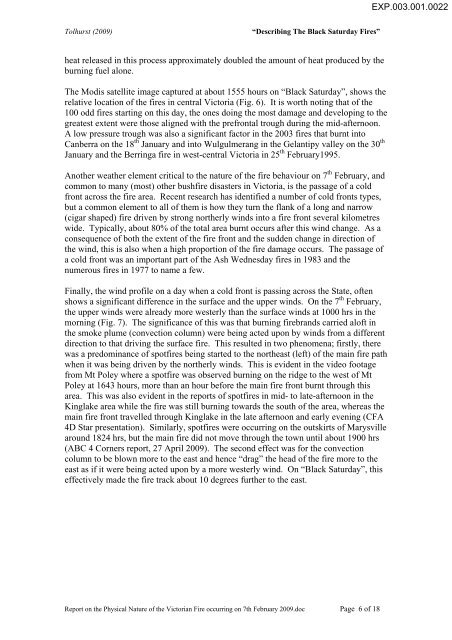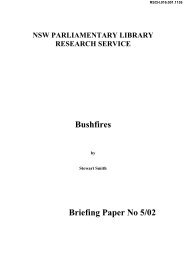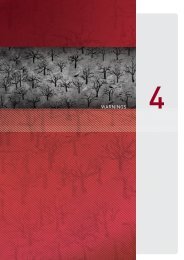Report on the Physical Nature of the Victorian Fires occurring on 7th ...
Report on the Physical Nature of the Victorian Fires occurring on 7th ...
Report on the Physical Nature of the Victorian Fires occurring on 7th ...
Create successful ePaper yourself
Turn your PDF publications into a flip-book with our unique Google optimized e-Paper software.
EXP.003.001.0022<br />
Tolhurst (2009)<br />
“Describing The Black Saturday <strong>Fires</strong>”<br />
heat released in this process approximately doubled <strong>the</strong> amount <strong>of</strong> heat produced by <strong>the</strong><br />
burning fuel al<strong>on</strong>e.<br />
The Modis satellite image captured at about 1555 hours <strong>on</strong> “Black Saturday”, shows <strong>the</strong><br />
relative locati<strong>on</strong> <strong>of</strong> <strong>the</strong> fires in central Victoria (Fig. 6). It is worth noting that <strong>of</strong> <strong>the</strong><br />
100 odd fires starting <strong>on</strong> this day, <strong>the</strong> <strong>on</strong>es doing <strong>the</strong> most damage and developing to <strong>the</strong><br />
greatest extent were those aligned with <strong>the</strong> prefr<strong>on</strong>tal trough during <strong>the</strong> mid-afterno<strong>on</strong>.<br />
A low pressure trough was also a significant factor in <strong>the</strong> 2003 fires that burnt into<br />
Canberra <strong>on</strong> <strong>the</strong> 18 th January and into Wulgulmerang in <strong>the</strong> Gelantipy valley <strong>on</strong> <strong>the</strong> 30 th<br />
January and <strong>the</strong> Berringa fire in west-central Victoria in 25 th February1995.<br />
Ano<strong>the</strong>r wea<strong>the</strong>r element critical to <strong>the</strong> nature <strong>of</strong> <strong>the</strong> fire behaviour <strong>on</strong> 7 th February, and<br />
comm<strong>on</strong> to many (most) o<strong>the</strong>r bushfire disasters in Victoria, is <strong>the</strong> passage <strong>of</strong> a cold<br />
fr<strong>on</strong>t across <strong>the</strong> fire area. Recent research has identified a number <strong>of</strong> cold fr<strong>on</strong>ts types,<br />
but a comm<strong>on</strong> element to all <strong>of</strong> <strong>the</strong>m is how <strong>the</strong>y turn <strong>the</strong> flank <strong>of</strong> a l<strong>on</strong>g and narrow<br />
(cigar shaped) fire driven by str<strong>on</strong>g nor<strong>the</strong>rly winds into a fire fr<strong>on</strong>t several kilometres<br />
wide. Typically, about 80% <strong>of</strong> <strong>the</strong> total area burnt occurs after this wind change. As a<br />
c<strong>on</strong>sequence <strong>of</strong> both <strong>the</strong> extent <strong>of</strong> <strong>the</strong> fire fr<strong>on</strong>t and <strong>the</strong> sudden change in directi<strong>on</strong> <strong>of</strong><br />
<strong>the</strong> wind, this is also when a high proporti<strong>on</strong> <strong>of</strong> <strong>the</strong> fire damage occurs. The passage <strong>of</strong><br />
a cold fr<strong>on</strong>t was an important part <strong>of</strong> <strong>the</strong> Ash Wednesday fires in 1983 and <strong>the</strong><br />
numerous fires in 1977 to name a few.<br />
Finally, <strong>the</strong> wind pr<strong>of</strong>ile <strong>on</strong> a day when a cold fr<strong>on</strong>t is passing across <strong>the</strong> State, <strong>of</strong>ten<br />
shows a significant difference in <strong>the</strong> surface and <strong>the</strong> upper winds. On <strong>the</strong> 7 th February,<br />
<strong>the</strong> upper winds were already more westerly than <strong>the</strong> surface winds at 1000 hrs in <strong>the</strong><br />
morning (Fig. 7). The significance <strong>of</strong> this was that burning firebrands carried al<strong>of</strong>t in<br />
<strong>the</strong> smoke plume (c<strong>on</strong>vecti<strong>on</strong> column) were being acted up<strong>on</strong> by winds from a different<br />
directi<strong>on</strong> to that driving <strong>the</strong> surface fire. This resulted in two phenomena; firstly, <strong>the</strong>re<br />
was a predominance <strong>of</strong> spotfires being started to <strong>the</strong> nor<strong>the</strong>ast (left) <strong>of</strong> <strong>the</strong> main fire path<br />
when it was being driven by <strong>the</strong> nor<strong>the</strong>rly winds. This is evident in <strong>the</strong> video footage<br />
from Mt Poley where a spotfire was observed burning <strong>on</strong> <strong>the</strong> ridge to <strong>the</strong> west <strong>of</strong> Mt<br />
Poley at 1643 hours, more than an hour before <strong>the</strong> main fire fr<strong>on</strong>t burnt through this<br />
area. This was also evident in <strong>the</strong> reports <strong>of</strong> spotfires in mid- to late-afterno<strong>on</strong> in <strong>the</strong><br />
Kinglake area while <strong>the</strong> fire was still burning towards <strong>the</strong> south <strong>of</strong> <strong>the</strong> area, whereas <strong>the</strong><br />
main fire fr<strong>on</strong>t travelled through Kinglake in <strong>the</strong> late afterno<strong>on</strong> and early evening (CFA<br />
4D Star presentati<strong>on</strong>). Similarly, spotfires were <strong>occurring</strong> <strong>on</strong> <strong>the</strong> outskirts <strong>of</strong> Marysville<br />
around 1824 hrs, but <strong>the</strong> main fire did not move through <strong>the</strong> town until about 1900 hrs<br />
(ABC 4 Corners report, 27 April 2009). The sec<strong>on</strong>d effect was for <strong>the</strong> c<strong>on</strong>vecti<strong>on</strong><br />
column to be blown more to <strong>the</strong> east and hence “drag” <strong>the</strong> head <strong>of</strong> <strong>the</strong> fire more to <strong>the</strong><br />
east as if it were being acted up<strong>on</strong> by a more westerly wind. On “Black Saturday”, this<br />
effectively made <strong>the</strong> fire track about 10 degrees fur<strong>the</strong>r to <strong>the</strong> east.<br />
<str<strong>on</strong>g>Report</str<strong>on</strong>g> <strong>on</strong> <strong>the</strong> <strong>Physical</strong> <strong>Nature</strong> <strong>of</strong> <strong>the</strong> <strong>Victorian</strong> Fire <strong>occurring</strong> <strong>on</strong> <strong>7th</strong> February 2009.doc Page 6 <strong>of</strong> 18

















